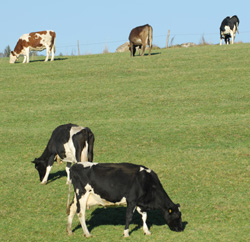Modelling greenhouse gas emissions from dairy farms
The dairy farming industry emits significant amounts of greenhouse gases (GHGs) to the atmosphere. The primary culprits are methane (CH4) and nitrous oxide (N2O), both of which are greenhouse gasses (GHGs) addressed by the Kyoto Protocol. The CH4 and N2O emissions originate from the cows as well as from the manure they produce. The MIDAIR project brought together fifteen research institutes to shed light on the exact magnitude regarding dairy farming's impact on climate change. In order to fill the gap in knowledge concerning emissions, measurement data was collected from fifteen model farms. Both conventional and organic farms were selected from five distinct European regions: Atlantic, Continental, Boreal, Pre-Alpine and Mediterranean. This data was supplemented with output from FarmGHG, a computer model developed at the Danish Institute of Agricultural Sciences, a member of the MIDAIR consortium. FarmGHG simulates carbon and nitrogen cycling at diary farms incorporating the entire supply chain. It enables the estimation of each farm's net emissions of CH4, N2O and other GHGs from both direct and indirect sources. During MIDAIR, FarmGHG was applied to the model farms to identify regional variation as well as variation between conventional and organic dairy farming. It was also used to determine the effectiveness of various proposals to reduce GHG emissions. The model was also extended to analyse other environmental problems associated with large-scale farming, such as eutrophication.







